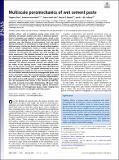| dc.contributor.author | Zhou, Tingtao | |
| dc.contributor.author | Ioannidou, Katerina | |
| dc.contributor.author | Ulm, Franz-Josef | |
| dc.contributor.author | Bazant, Martin Z | |
| dc.contributor.author | Pellenq, RJ-M | |
| dc.date.accessioned | 2021-10-27T20:11:06Z | |
| dc.date.available | 2021-10-27T20:11:06Z | |
| dc.date.issued | 2019 | |
| dc.identifier.uri | https://hdl.handle.net/1721.1/135174 | |
| dc.description.abstract | © 2019 National Academy of Sciences. All rights reserved. Capillary effects, such as imbibition drying cycles, impact the mechanics of granular systems over time. A multiscale poromechanics framework was applied to cement paste, which is the most common building material, experiencing broad humidity variations over the lifetime of infrastructure. First, the liquid density distribution at intermediate to high relative humidity is obtained using a lattice gas density functional method together with a realistic nanogranular model of cement hydrates. The calculated adsorption/desorption isotherms and pore size distributions are discussed and compare well with nitrogen and water experiments. The standard method for pore size distribution determination from desorption data is evaluated. Second, the integration of the Korteweg liquid stress field around each cement hydrate particle provided the capillary forces at the nanoscale. The cement mesoscale structure was relaxed under the action of the capillary forces. Local irreversible deformations of the cement nanograins assembly were identified due to liquid-solid interactions. The spatial correlations of the nonaffine displacements extend to a few tens of nanometers. Third, the Love-Weber method provided the homogenized liquid stress at the micrometer scale. The homogenization length coincided with the spatial correlation length of nonaffine displacements. Our results on the solid response to capillary stress field suggest that the micrometer-scale texture is not affected by mild drying, while nanoscale irreversible deformations still occur. These results pave the way for understanding capillary phenomenainduced stresses in heterogeneous porous media ranging from construction materials to hydrogels and living systems. | |
| dc.language.iso | en | |
| dc.publisher | Proceedings of the National Academy of Sciences | |
| dc.relation.isversionof | 10.1073/pnas.1901160116 | |
| dc.rights | Article is made available in accordance with the publisher's policy and may be subject to US copyright law. Please refer to the publisher's site for terms of use. | |
| dc.source | PNAS | |
| dc.title | Multiscale poromechanics of wet cement paste | |
| dc.type | Article | |
| dc.contributor.department | Massachusetts Institute of Technology. Department of Physics | |
| dc.contributor.department | Massachusetts Institute of Technology. Department of Civil and Environmental Engineering | |
| dc.contributor.department | Massachusetts Institute of Technology. Department of Mathematics | |
| dc.contributor.department | Massachusetts Institute of Technology. Department of Chemical Engineering | |
| dc.relation.journal | Proceedings of the National Academy of Sciences of the United States of America | |
| dc.eprint.version | Final published version | |
| dc.type.uri | http://purl.org/eprint/type/JournalArticle | |
| eprint.status | http://purl.org/eprint/status/PeerReviewed | |
| dc.date.updated | 2019-08-14T13:05:55Z | |
| dspace.orderedauthors | Zhou, T; Ioannidou, K; Ulm, F-J; Bazant, MZ; Pellenq, RJ-M | |
| dspace.date.submission | 2019-08-14T13:05:57Z | |
| mit.journal.volume | 116 | |
| mit.journal.issue | 22 | |
| mit.metadata.status | Authority Work and Publication Information Needed | |
